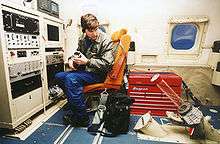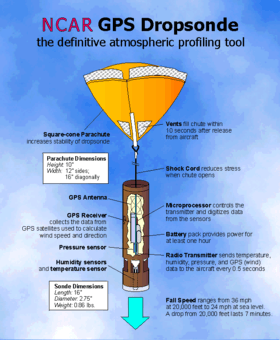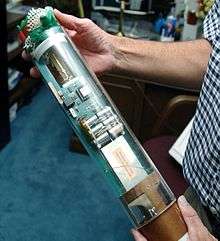Dropsonde

A dropsonde is an expendable weather reconnaissance device created by the National Center for Atmospheric Research (NCAR), designed to be dropped from an aircraft at altitude to more accurately measure (and therefore track) tropical storm conditions as the device falls to the surface. The sonde contains a GPS receiver, along with pressure, temperature, and humidity (PTH) sensors to capture atmospheric profiles and thermodynamic data. It typically relays these data to a computer in the aircraft by radio transmission.
The device's descent is slowed and stabilized by a small square-cone parachute, allowing for multiple readings to be taken before it reaches the ocean surface. The sonde is a lightweight system designed to be operated by one person and is launched through a chute installed in the measuring aircraft, with immediate deployment of the parachute to reduce or eliminate any pendulum effect, and typically drops from three to five minutes. The sonde has a casing of stiff cardboard. During a typical hurricane season, the 53d Weather Reconnaissance Squadron Hurricane Hunters deploys 1000 to 1500 sondes on training and storm missions.
Description

Dropsondes are commonly used by Hurricane Hunters to obtain meteorological data on hurricanes, and these data are then fed into supercomputers for numerical weather prediction, enabling forecasters to track and predict what will happen to the hurricane. To obtain the data, an aircraft, either operated by NOAA or the U.S. Air Force flies into the hurricane. The dropsonde is released when the plane reaches the eye (center) of the hurricane, normally at around 10,000 feet (approx. 3,000 meters). The dropsonde sends back coded data, which includes:
- The date and time of the drop. Time is always in UTC.
- Location of the drop, indicated by the latitude, longitude, and Marsden square.
- Standard isobaric surfaces: the height, temperature, dewpoint depression, wind speed, and wind direction at the surface, and at where the following air pressures are found as the dropsonde is descending: 1000, 925, 850, 700, 500, 400, 300, 250 hectopascals (hPa).
- Significant isobaric surfaces: the temperature and dewpoint depression of other levels of atmospheric pressure deemed significant
- Air pressure, temperature, dewpoint depression, wind speed and wind direction of the tropopause.
Also included in the report is information on the aircraft, the mission, the dropsonde itself, and other remarks.
Driftsondes

A driftsonde is a high altitude, durable weather balloon holding a transmitter and a bank (35 in the first models) of miniature dropsonde capsules. These water-bottle-sized transmitters have enough power to send information to the balloon during their parachute-controlled fall. The balloon carries a transmitter powerful enough to relay readings to a satellite. The single-use sensor packages cost US$300 to $400 each.[1]
After being introduced in April 2007, around a thousand a year are expected to be used to track winds in hurricane breeding grounds off of West Africa, which are outside the operating areas of Hurricane Hunter planes.[1]
See also
References
- 1 2 "Balloons Track Storms And Save Lives: Atmospheric Scientists And Meteorologists Use Driftsondes For Hurricane Forecasts". Science Daily. April 1, 2007. Retrieved 2013-05-24.
External links
| Wikimedia Commons has media related to Radiosonde and dropsonde. |